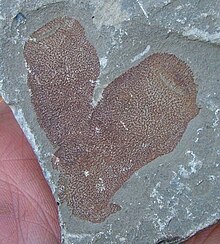| Hazeliidae Temporal range: Chengjiang–Middle Ordovician PreꞒ Ꞓ O S D C P T J K Pg N | |
|---|---|

| |
| A specimen of Hazelia at the Mount Stephen Trilobite Beds | |
| Scientific classification | |
| Domain: | Eukaryota |
| Kingdom: | Animalia |
| Phylum: | Porifera |
| Class: | Demospongiae |
| Order: | †Protomonaxonida |
| Family: | †Hazeliidae Walcott, 1920 |
| Genera | |
| |
Hazeliidae is an extinct family of spicular Cambrian sea sponges known from the Burgess Shale, the Marjum Formation of Utah, and possibly Chengjiang. It was described by Charles Walcott in 1920.
References
- ^ Botting, J. (2007). "'Cambrian' demosponges in the Ordovician of Morocco: Insights into the early evolutionary history of sponges". Geobios. 40 (6): 737–748. doi:10.1016/j.geobios.2007.02.006.
- Rigby, J. K. (1986). "Sponges of the Burgess shale (Middle Cambrian), British Columbia". Palaeontographica Canadiana (2).
- J. Keith Rigby; Lloyd F. Gunther; Freida Gunther (1997). "The First Occurrence of the Burgess Shale Demosponge Hazelia palmata Walcott, 1920, in the Cambrian of Utah". Journal of Paleontology. 71 (6): 994–997. doi:10.1017/S0022336000035976. JSTOR 1306598. S2CID 130706440.
| Taxon identifiers | |
|---|---|
| Hazeliidae | |
This article related to a Cambrian animal is a stub. You can help Misplaced Pages by expanding it. |
This article related to an Ordovician animal is a stub. You can help Misplaced Pages by expanding it. |
This article about a demosponge is a stub. You can help Misplaced Pages by expanding it. |